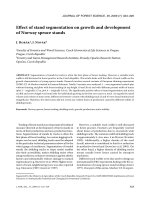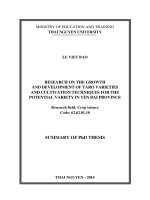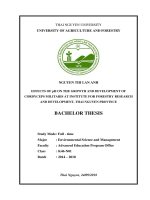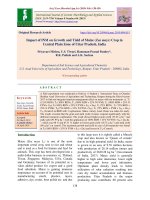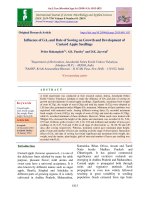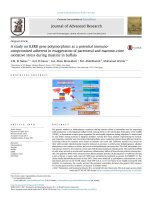Study on growth and development of some potential tomato lines in winter spring season in gia lam ha noi
Bạn đang xem bản rút gọn của tài liệu. Xem và tải ngay bản đầy đủ của tài liệu tại đây (2.8 MB, 65 trang )
VIETNAM NATIONAL UNIVERSITY OF AGRICULTURE
FACULTY OF AGRONOMY
----------••&••----------
UNDERGRADUATE THESIS
STUDY ON GROWTH AND DEVELOPMENT OF
SOME POTENTIAL TOMATO LINES IN WINTERSPRING SEASON IN GIA LAM - HANOI
Supervisor
: PhD.VU QUYNH HOA
Department : HORTICULTURE AND LANDSCAPING
Student
: DO THI TOAN
Class
: K61KHCTT
Student code : 611645
HA NOI - 2021
ACKNOWLEDGEMENTS
During the process of completing this graduation thesis, in addition to my
own efforts, I also received a lot of attention and help from many teams and
individuals.
First of all, I would like to express my sincere and deep gratitude to PhD. Vu
Quynh Hoa - teacher of the Department of Horticulture and Lanscaping for
direct guidance, enthusiastic guidance and creating all conditions for me to
complete report.
I would like to express my sincere thanks to the teachers in the Department
of horticulture and lanscaping Faculty of Agriculture, Vietnam Academy of
Agriculture for helping, guide me during my studies at school.
Finally, I would like to sincerely thank my relatives and friends who have
wholeheartedly helped and encouraged me in the learning process as well as
completing the report.
I sincerely thank!
Hanoi, February 26th , 2021
Student
i
DECLARATION
I declare that the thesis is the result of my own research. The data and
results mentioned in this thesis are honest and not used in any published thesis,
dissertations, and scientific research projects previously.
I hereby commit that the information cited in the thesis ensuring cited as
prescribed. I bear full responsibility for these reassurances.
Hanoi, February 26th , 2021
Student
ii
TABLE OF CONTENTS
ACKNOWLEDGEMENTS ................................................................................... i
DECLARATION .................................................................................................. ii
Table ..................................................................................................................... iii
ABSTRAC............................................................................................................ iv
I. INTRODUCTION .......................................................................................... 1
1.1. THE IMPERATIVENESS OF THE THESIS .......................................... 1
1.2. OBJECTIVES AND REQUIREMENTS ................................................. 2
1.2.1. Objectives ........................................................................................... 2
1.2.2. Requirements ...................................................................................... 2
II.
LITERATURE REVIEW ............................................................................ 3
2.1. ORIGIN, AND CLASSIFICATION OF TOMATO ................................ 3
2.1.1. Origin.................................................................................................. 3
2.1.2. Classification ...................................................................................... 3
2.2. BOTANICAL CHARACTERISTICS ..................................................... 4
2.2.1. Root .................................................................................................... 4
2.2.2. Stem .................................................................................................... 4
2.2.3. Leaves ................................................................................................. 5
2.2.4. Flower ................................................................................................. 5
2.2.5. Fruit .................................................................................................... 5
2.2.6. Seed .................................................................................................... 5
2.3. REQUIREMENTS ON ECOLOGICAL FACTORS FOR GROWTH
AND DEVELOPMENT OF TOMATO PLANTS. ........................................... 6
2.3.1. Light ................................................................................................... 6
2.3.2. Temperature........................................................................................ 6
2.3.3. Water .................................................................................................. 6
2.3.4. Soil...................................................................................................... 7
iii
2.4. NUTRITION, MEDICINE AND ECONOMY ........................................ 7
2.4.1. Nutrition ............................................................................................. 7
2.4.2. Medicine ............................................................................................. 7
2.4.3. Economy ............................................................................................. 8
2.5. THE STATUS OF PRODUCTION AND CONSUMPTION OF
TOMATO IN THE WORLD AND IN VIETNAM. ......................................... 9
2.5.1. The status of tomato production and consumption in the world. ....... 9
Figure 2.1. Situation of tomato production in the world and in regions ... 10
2.5.2. The status of tomato production and consumption in Vietnam. ...... 12
2.6. SOME STUDIES OF TOMATOES IN THE WORLD AND
VIETNAM. ...................................................................................................... 13
2.6.1. Some studies of tomatoes in the world ............................................ 13
2.6.2. Some studies of tomatoes in Vietnam .............................................. 15
III.
MATERIALS AND METHODS .............................................................. 18
3.1. Materials ................................................................................................. 18
3.2. Experimental site and time ..................................................................... 18
3.3. Methods .................................................................................................. 19
3.4. Experiment observation .......................................................................... 20
3.4.1. Growth and development stage in the field. .................................... 20
3.4.2. Evaluating the morphology, plant structure of tomato. ................... 20
3.4.3. Flowering characteristics.................................................................. 20
3.4.4. Criterion on fruit morphology and quality ....................................... 21
3.4.5. Evaluating yield and yield contributes. ............................................ 21
3.4.6. Assessment the level of infection with some pests and diseases in the
field
.......................................................................................................... 21
3.4.7. Statistical analysis method ............................................................... 22
IV.
RESULTS AND DISCUSSION ................................................................ 23
4.1. Time of growth and development........................................................... 23
iv
4.1.1. Time of growth in the nursery .......................................................... 23
4.1.2. Growth time of tomato cultivars ...................................................... 25
4.2. Morphological and vegetative characteristics of plants ......................... 27
4.2.1. Stem .................................................................................................. 27
4.2.2. Leaf ................................................................................................... 30
4.2.2.1. Length and width of leaves of tomato plants ............................. 32
4.2.2.2. Morphological and vegetative characteristics of the leaf .......... 34
4.2.3. Fruit .................................................................................................. 36
4.2.4. Fruit quality ...................................................................................... 38
4.3. Yield and yield components ................................................................... 41
4.4. Diseases .................................................................................................. 42
V. CONCLUSIONS........................................................................................... 45
VI.
SUGGESTION .......................................................................................... 45
REFERENCE ...................................................................................................... 46
v
TABLE OF FIGURE AND TABLE
Figure
Figure 2.1. Situation of tomato production in the world and in regions ................. 10
Table
Table 2.1. The situation of tomato production of some leading countries in the
world in 2020 .......................................................................................................... 11
Table 2.2: The status of tomato production in Vietnam ......................................... 12
Table 4.1: Time and percentage of seed germination ............................................. 23
Table 4.2: Percentage of tomato plant alive ............................................................ 24
Table 4.3: Growth time of tomato cultivars ............................................................ 25
Table 4.4: Height of plant after transplanting ......................................................... 27
Table 4.5: The number of branch of tomato plant .................................................. 29
Table 4.6: The number real leaves of tomato plant................................................. 31
Table 4.7: length of leave tomato plant ................................................................... 32
Table 4.8: Width of leave tomato plant ................................................................... 33
Table 4.9: Morphological and vegetative characteristics of the leaf ...................... 35
Table 4.10: Morphological and vegetative characteristics of the fruit of tomato ... 37
Table 4.11: Fruit quality of tomato plant ................................................................ 39
Table 4.12: Yield and yield components of tomato plant ....................................... 41
Table 4.13: Diseases incidence of tomato plant ...................................................... 42
iii
ABSTRAC
The main objective of this study is to evaluate the growth ability and yield of
tomato cultivars during winter-spring season 2020–2021 in Gia Lam, Ha Noi. A
total of eighteen cultivar treatments were used, namely V13, V14, V19, V20,
V21, V26, V29, V22, V30, V31, V32, VG8C, VG8N, V10, V11, VA, V14DB,
V27. The field experiment was laid out in a randomized complete block design
with three replications. Ten plants per replication were examined. To be able to
evaluate the agronomic characteristics of tomato strains, it is necessary to have
research methods, that is to observer relevant indicators of growth and
development, including: the development stages of the plant, growth dynamics
in terms of height, number of leaves, length and width of leaves. Yield
characteristics such as fruiting rate, and factors constituting yield. So can
calculate the individual productivity of the tomato cultivars. Continue to monitor
the morphological characteristics and fruit quality. From there, make a table,
compare with the lines in the research group to produce the results. By
monitoring and evaluating the whole process as well as from the results
obtained, V19, V22, V30, V32, VG8N have actual yield ranging 4.008 to 2.61
kg/m2.
The Brix degree of high fruit quality ranges from 5.8 to 7.5 Bx.
Therefore, these cultivars can be considered as promising for tomato breeding
and cultivation in next crops.
iv
I.
INTRODUCTION
1.1.
THE IMPERATIVENESS OF THE THESIS
Vegetables are one of the necessary foods in human daily meals.
Especially in the current development of science and technology, the market
also requires clean products, beautiful designs and good quality. The vegetable
industry is an important part of agricultural production. Currently, tomato is
population agricultural product that brings high economic value to our country
and is an object to study. Tomato (Solanum Lycopersicon Mill) belonging to the
Solanaceae family originates in western South America. This crop is considered
as one of the popular and second most consumed vegetables worldwide after
potato. In raw red tomatoes, carbohydrates, fat, protein, vitamins, minerals, and
other constituents (water, and lycopene) that support human health are found.
On the other hand, tomato is widely consumed as a raw vegetable or processed
products. It is usually used to make a salad with other leafy vegetables and in
sandwiches. It can be fried, stewed, and baked alone or in combination with
other vegetables. It is an essential ingredient in pasta, hamburgers, pizzas, hot
dogs, and other foods. In addition to the nutritional value, tomatoes also have
medicinal values: the pulp helps digestion, laxative, promotes stimulates gastric
secretion and dialysis, intestinal disinfection, ulcers, mouth pain. Tomato juice
stimulates the liver, keep stomach and intestines in good condition. Young
leaves of tomatoes, crushed on pimples twice a day will heal. Tomatine
substance extracted from dried tomato leaves has antimicrobial, anti-fungal, and
anti-fungal effects. In Vietnam, tomatoes are one of the oldest plants about over
100 years used as either a main fruit or a vegetable crop. Until present, it has
been a crop prioritized for development in domestic agriculture. According to
the statistics in 2013, the cultivation area was about 23.91 thousand hectares and
mainly spread in the Red River Delta area such as Ha Noi, Hai Phong, Hai
Duong, Thai Binh, Hung Yen, Bac Giang, Nam Dinh…. In recent years, in our
1
country, tomatoes are not only grown in the winter (main season) but also in the
early season (Autumn-Winter), late season (Winter-Spring) and Spring-Summer
season. This is an important technical and technological step forward in the
tomato industry, which is both meaningful in solving off-season vegetables and
improve economic efficiency for producers. However, in Vietnam, tomato
production still has many shortcomings, such as not having enough varieties for
production, not having good varieties for each crop and suitable for different
ecological regions. Following the fact mentioned above, we do a research on:
“Study on growth and development of some potential tomato lines in winterspring season in Gia Lam – Hanoi.”
1.2.
OBJECTIVES AND REQUIREMENTS
1.2.1. Objectives
- Evaluation the agronomical and morphological features concerning the
growth time, stem, leaf, flower, and fruit of tomato varieties.
- Based on the valuation, select the preeminent lines, high yield, good
agricultural-biological characteristics, have disease resistance and adaptation to
environmental conditions.
1.2.2. Requirements
- Measure agronomic characters: plant height, number of nodes from foot
to the first flower (node), height from foot to the first flower (cm), plant height
(cm), and growth type, leaf (length, width), flower, fruit of tomato.
- Yield and yield components: number of fruits per plant fruit weight,
fruit weight, theoretical yield, actual yield
- Measure the level of pests and diseases infestation in the field.
- Compare some characteristics of growth and development between
lines.
2
II.
LITERATURE REVIEW
2.1.
ORIGIN, AND CLASSIFICATION OF TOMATO
2.1.1. Origin
Tomato is originated in Western South America and Central America. Its
domestication and use as a cultivated food may have originated with the
indigenous peoples of Mexico.
The Aztecs used tomatoes in their cooking at the time of the Spanish
conquest of the Aztec Empire, and after the Spanish encountered the tomato for
the first time after their contact with the Aztecs, they brought the plant to
Europe. From there, the tomato was introduced to other parts of the Europeancolonized world during the 16th century.
It was considered poisonous until 18th century. First introduction in US in
1710: Thomas Jefferson was one of the first to grow tomatoes, which were
called “Love Apples” at the time.
First introduced in Vietnam in 19th century during French domination
period.
2.1.2. Classification
The cultivated tomato is a member of the genus Solanum within the family
Solanaceae. The Solanaceae, commonly known as the nightshade family, also
includes other notable cultivated plants such as tobacco, chilli pepper, potato
and eggplant. Tomato classification is classified by many authors, but the
Muller’s classification is the most widely used to. According to Muller genus
Lycopersicon is divided into two sub-genus:
- Genus Eriopersicon: this genus includes wild plant, annual or multi-year
plants. The fruit has feathers, green or light yellow rind, streaks with
Anthocyanin pigments, small seeds, streaks with Anthocyanin pigments. This
genus including:
3
L.peruvianumm. Mill; L.cheesmanii. Mill; L.hirsutum; L. glandulosum.
- Genus Eulycopersicon: belong to annual plants, no has feathers, fruit
ripe is red or yellow, big seeds, this group consist of:
• L.pimpinellifolium: the stem is thin, the fruit is small red, the flowers
grow in clusters of 15-20 fruit/ cluster, the fruit has two-septum.
• L.esculentum: is a cultivated tomato that grows finite to infinite
This genus inchuding:
✓ L.esculentum var. Commune: Stems, leaves are dense must cut branches,
flowers, fruits from medium to large weight.
✓ L.esculentum var. Cerasiforme: cherry tomatoes are small, thin leaves,
flowers grow in long clusters, about 10 flowers / cluster, red or yellow.
✓ L.esculentum var. Pyriforme: tomato is shape pear, type of unlimited,
about 10 fruits/cluster, fruit is yellow or orange.
✓ L.esculentum var. Grandiforlium: The leaves of this line resemble potato
leaves, the leaf surface is broad and gloss, the number of leaves is low to
medium.
✓ L.esculentum var. Vadium: cherry tomato, is type of finite grow, fat and
short, leaf is dark green, curly and many leaves.
2.2.
BOTANICAL CHARACTERISTICS
2.2.1. Root
Root of tomato is fasciculate root, it can be grow broad to 1.3m and deep
1m so it is a drought tolerance.
2.2.2. Stem
The stem when young is soft, watery, has yellowish fluid, brittle, easy
broke the whole stem is covered with a thin layer of feather, the lower stem is
sclerosis, especially the part close to the ground.
4
2.2.3. Leaves
Tomato leaves are double leaf type, the leaflets are serrated, there are
many types of leaves such as: crow's feet, potato leaves, capsicum leaves, ....
depending on the variety, the size of tomato leaves and colors are difference.
2.2.4. Flower
Flowers grow in clusters. There are 3 types of inflorescence: simple,
intermediate and complex. Number of flowers / cluster, number of clusters /
plants depends on variety. The number of flower clusters / plants is 4-20, the
number of flowers / cluster is from 2-26 flowers. Sepals are yellow, the number
of sepals and the number of petals is 5-9 respectively. hermaphrodite flowers,
male stamens linked together into a conical envelope, covering the female
stamen.
2.2.5. Fruit
The fruit is a berry, with 2,3 or more seed septas. Fruit shape and color
depend on the variety. In addition, the shape of ripe fruit depends on
temperature, and depends on the carotene and lycopene content. At 30 ° C or
above, lycopene synthesis is inhibited, while β-Carotene synthesis is insensitive
to the effects of temperature. So in the hot season tomatoes are ripe yellow or
reddish-yellow. Fruit weight varies greatly from 2-300g depending on variety,
with fruit up to 500g.
2.2.6. Seed
Seeds are small, flat, pointed, with a bright yellow, dark yellow or light
yellow stalk, seeds of some species are clearly fuzz.
5
2.3.
REQUIREMENTS ON ECOLOGICAL FACTORS FOR GROWTH
AND DEVELOPMENT OF TOMATO PLANTS.
2.3.1. Light
Tomatoes belong to light-loving plants, in the nursery, if seedlings are
enough light (5000 lux), they will have good quality, hard plants, strong leaves.
In addition, the light is good, the intensity of photosynthesis increases, the plants
flower sooner, and the product quality is higher (Tran Khac Thi, 1999). Low
light intensity, plants slows down growth and hinders flowering resulting in low
yield.
2.3.2. Temperature
Tomatoes grow well in the temperature range from 15-30oC, the optimal
temperature is 22-24oC (Lorenz Maynard 1988). Photosynthesis of tomato
leaves increases when the temperature the optimum 25-30oC, when the
temperature is higher than the appropriate level, photosynthesis will decrease.
Day and night temperature also affects plant growth: a day temperature of 1520oC, suitable for plants to grow (Kuo et al). Suitable night temperature from
13-18oC.
2.3.3. Water
Tomato plants are relatively drought-tolerant, but require a lot of water
because of the large amount of stalks and leaves on the ground. Water
requirements of tomato plants during growth are also very different. When the
plant is fruiting and the fruit is growing, the tree needs the most water. When the
soil is dry, flowers and young fruit fall easily. If the soil is excessively hydrated,
the root system is damaged the plant is susceptible to pests and diseases. If it
rains heavily at this time, the fruit will ripen slowly and easily crack.
6
2.3.4. Soil
Tomatoes can be grown in many different types of soil, but the most
suitable is still sandy soils, silty soils or alluvial soils. Soils retain moisture,
drain well and contain at least 1.5% organic matter. PH range 5.5-7.5, most
suitable from 6-6.5.
2.4.
NUTRITION, MEDICINE AND ECONOMY
2.4.1. Nutrition
Tomato is a vegetable with high nutritional value, in ripe tomatoes with
the most sugar is glucose, many vitamins: carotene, B1, B2, C, amino acids and
important minerals: Ca, P, Fe, ...
According to Edward C. Tigchelaar (1989), the chemical composition of
tomatoes is as follows:
Water: 94-95%
Dry matter: 5-6%
In dry matter include:
Sugar (glucose, fuctose, sucrozo): 55%
Alcohol insoluble substances (proteins, cellulose, pectin, polysaccharides):
21%
Organic acids (citric, malic, galacturolic, pyrolidon-caboxylic): 12%
Inorganic: 7%
Other substances (carotenoids, ascorbic, volatile substances, amino acids, ...):
5%
2.4.2. Medicine
According to traditional medicine, tomatoes have a sweet and sour taste,
cool properties, are used to heat, refresh, nourish and cool the blood, often used
to cure diseases such as heat, dry lips, thirst due to the taste of heat, dizziness or
7
dizziness, nosebleeds, bleeding teeth, poor digestion, stomach ulcers, high blood
pressure ... Tomatoes are indicated for eating or taking fruit juices to treat
depression, appetite, poisoning. chronic, excess blood, blood too sticky,
hardening of the arteries, organs, rheumatism, rheumatism, excess urea in the
blood, enteritis .... According to Vo Van Chi (2002), tomatoes provide energy,
provide minerals, increase vitality, balance cells, appetizers, cool off, anti-septic
(scurvy), anti-bacterial, anti-toxic, alkaline blood is too acidic, diuretic, urea
excretion, help digestion starch.
In tomatoes, lycopene - the component that makes up the red color of
tomatoes - helps reduce the risk of cardiovascular disease. This is a natural
antioxidant that is 100 times more potent than vitamin E-related lycopene, which
has been shown to prevent prostate cancer. With more tomatoes, the rate of
oxidation damage to biochemical structures of DNA is lowest. Healthful
tomatoes of all ages. For women, eating a lot of tomatoes will have healthy and
beautiful skin, reduce the risk of obesity and reduce the risk of breast cancer.
2.4.3. Economy
Due to its rich nutritional content, tomatoes have become a popular dish
in many countries. Therefore, tomatoes are a vegetable with high economic
efficiency and an important export item of many countries: such as Taiwan
annually exports tomatoes with a total value of up to 95,000 USD and 40,800
USD of processed tomatoes. According to the authors G.W. and Mc. Collum
(1997), the average income per hectare in the US is as follows: tomato: 4,610
USD, wheat: 174 USD, wet rice 1,027 USD and other vegetables averaged
2,537 USD.
The amount of tomatoes exchanged on the world market in 1999 was 36.7
tons, of which tomatoes used in fresh form was only 5-7%. In the US (1997) the
8
total production value of 1 hectare tomato was four times higher than that of wet
rice, 20 times higher than wheat (cited by Ta Thu Cuc, 1985).
In Vietnam, although it appeared more than 100 years ago, tomatoes have
been a very popular and important fruit vegetable. According to survey data of
the market research department of the Fruit and Vegetable Research Institute,
producing tomatoes in the Red River Delta has an average income of 42.0 - 68.4
million VND / ha / crop with a net profit of 15 - 25 million VND / ha, many
times higher than rice cultivation.
2.5.
THE STATUS OF PRODUCTION AND CONSUMPTION OF
TOMATO IN THE WORLD AND IN VIETNAM.
2.5.1. The status of tomato production and consumption in the world.
According to the Food and Agriculture Organization of the United
Nations (FAOSTAT, 2020), the world tomato acreage in 2018 reached 4,762
million hectares, yield 38.27 tons / ha, output 182.256 million tons. With the
above tomato production, per capita consumption is about 24 kg fruit / person /
year. In particular, the Asian region accounts for 61.3% of the world's output
with 111,683 million tons and the 5 largest tomato producers are: China, EU,
India, USA and Turkey. They account for 70% of global production. Tomato
production increased sharply in acreage in recent decades, led by China and the
US, but the US was the largest tomato importer and the largest exporter was
Spain, then Mexico.
9
Figure 2.1. Situation of tomato production in the world and in regions
10
Table 2.1. The situation of tomato production of some leading countries in
the world in 2020
Production
Area harvested
Yield
Continents
(tones)
(ha)
(kg/ha)
China
61,63
1,04
59,26
America
12,612
0,13
Turkey
12,15
0,176
69,03
Iran
6,577
0,158
41,63
Italy
5,798
0,097
59,77
Spain
4,768
0,056
85,14
Brazil
4,11
0,057
72,11
97,02
( FAOSTAT, 2020)
Among the countries with large tomato areas in the world, China has the
largest tomato area, followed by India, Turkey, Egypt, the United States, ... The
area is not proportional to Tomato yield, with a very large cultivated area, but
India's tomato yield is relatively low, lower than the world average and reaching
24.84 tons / ha. The leading yield countries are the US (97.02 tons / ha), Spain
(85.14 tons / ha), Brazil (72.11 tons / ha), Turkey (69.03 tons / ha). 1.8 to 2.54
times higher than the world average yield (38.27 tons / ha). This means that
developed countries have high scientific and technical qualifications, have the
infrastructure and conditions to apply high-tech technologies, farming conditions in
greenhouses, net houses, Actively in production will achieve high productivity,
while countries with limited scientific and technical qualifications, have no
conditions to apply to production, cultivation conditions mainly in the field,
depending on In nature, productivity will be lower.
11
2.5.2. The status of tomato production and consumption in Vietnam.
Tomatoes have been introduced to Vietnam for more than 100 years but
have become a popular vegetable and are used more and more widely. Tomatoes
in our country are grown mainly in the winter with an area of about 23,868 ha
(table 2.5) and often concentrated in the provinces of the Northern Plains and
Midlands (Hanoi, Hai Duong, Vinh Phuc ...), while in the Central Nam
concentrated in the provinces of An Giang, Tien Giang, Lam Dong ...
Year
2005
Table 2.2: The status of tomato production in Vietnam
Area harvested
Yield
Production
(ha)
(tons/ha)
(tons)
23.566
19,8
466.124
2006
22.962
19,6
450.426
2007
23.283
19,7
458.214
2008
24.850
21,6
535.438
2009
20.540
24,1
494.332
2010
21.784
25,3
550.183
2011
23.084
25,6
589.830
2012
23.918
25,8
616.890
2016
23.868
27,4
655.442
Source: Data of the General Statistics Office 2016
From 1997-2000, the first "revolution" in tomato production in the
country occurred with the introduction of hot-tolerant hybrid tomatoes grown in
many seasons. In the 2005-2016 period, the area of tomatoes increased from
23.566 – 23.868 (ha), productivity and production increased significantly from
19,8-27,4 (quintals / ha). (table 2.5)
Tomatoes are a fruit vegetable that has held an important position and is
the focus of research by plant breeders in the future. Thanks to that, a series of
new tomato varieties with high yield and good quality were born to meet the
12
increasing demands of the market. To serve that work, it is necessary to use a lot
of methods such as breeding, selection, mutation treatment, in-vitro culture ...
However, in comparison with the general development of the world, the
area and productivity in our country are still very low. It is predicted by some
experts that in the next few years the area and yield of tomatoes will increase
rapidly due to:
- Breeders in the coming years will offer mass production the varieties have
advantages in both productivity and quality, suitable for each ecological region,
each season.
- New scientific and technological advances will be instructed and
disseminated to the farmers in the provinces
- Vietnam has put into a tomato processing factory under a modern line in
Hai Phong with a capacity of 10 tons of raw materials / day. Therefore, the
planning of tomato growing areas to supply raw materials for the factory is
becoming more urgent especially in the provinces of Hai Phong, Hanoi, Hung
Yen, Hai Duong and Thai Binh.
2.6.
SOME STUDIES OF TOMATOES IN THE WORLD AND
VIETNAM.
2.6.1. Some studies of tomatoes in the world
The tomato originated from South America and was brought to Europe by
the Spanish in the 16th century. Wild tomatoes are small, green and largely
unappetizing, but after centuries of breeding there are now thousands of varieties
grown worldwide. The tomato is now grown worldwide for its edible fruits, with
thousands of cultivars (about 7,500) having been selected with varying fruit
types, and for optimum growth in differing growing conditions.
Tomato plants have attracted the interest of many scientists around the
world. The research about it for the purpose of creating new varieties with
13
genetic characteristics consistent with the needs of humans. Each breeder has
different methods such as: Selection of individual, sexual hybrid, using
heterosis.
In the United States, tomato varieties were selected very early and gained
many significant achievements. Liberty's experiment, Hyde Bailey at Michigan
Agricultural School (USA) began in 1886, the author has selected and classified
cultivated tomatoes. The University of California has selected new tomato
varieties such as UC-105, UC-82, UC-134 with higher yield than VE-145 and
has many good features such as: hard fruit, high tolerance to fruit cracking.
A tomato variety with the same combination of PG gene and NPT II was
commercialized in 1996 through a collaboration between Petoseed Company
and Zeneca Plant Science. That variety was approved for food and tomato
production in the U.S. by the Food and Drug Administration in 1994 and the
U.S. Department of Agriculture in 1995. It also was approved for food
consumption by the government of the United Kingdom in 1995 and in Canada
by Health Canada in 1996. That variety also passed scientific review in the
European Union. It was grown commercially in California and sold as tomato
paste product in the United Kingdom between 1996 and 1999.
Many studies on selection of heat-resistant tomato varieties have been
conducted in India, Thailand and China and some other countries in the world.
In 1981, the Punjab Agricultural University in Ludhiana, chose to create the
Punjab chuhara. Plant dwarf, bushy with dense and luxuriant foiage. Fruit
medium sized, pear shaped, firm, fleshy, less seedy, less sour, thick walled,
uniformly red colored at maturity, retain marketable quality for a week after
harvesting during summer. Punjab Kesri hybrid developed in 1987. Av. Plant
height 60 cm, bushy, no fruit cracking, early maturity, incidence of late blight
and fruit borer moderate, susceptible to root knot nematodes.
14
Research on the volatility of the pollen, the fruiting rate under the impact
of two modes of heat (high temperature and optimum temperature), Abdul and
Stommel (1995) concluded: “Genotype and heat treatment effects were
significant for electrolyte leakage, numbers of inflorescences, numbers of
flowers, number of fruit, fruit set, fresh fruit weight, fresh plant weight and dry
plant weight. Those traits most impacted by heat stress included numbers of
fruit, fruit weight and fruit set”.
In 1992, Technisem is a vegetable breeding company in French launched
tomato varieties with heat resistance, high ability, firm fruit, high dry matter
content, transport resistance, good quality, insect resistance. diseases such as
Roma VF, Rossol VFA, F1 campa ... (Tran Thi Minh Hang, 1999)
2.6.2. Some studies of tomatoes in Vietnam
Tomatoes were the main object of the study of vegetable varieties in
Vietnam in the early 70s of last century. Participating in this work are the
research institutes of the Ministry of Agriculture and Rural Development: The
Institute of Food Crops, Food Crops, the Vegetable Research Institute, the
Vietnam Agricultural Science and Technology Institute, the Agricultural
Genetics Institute, Viet Nam university of agricultural, Thu Duc University, Quy
Nhon Pedagogy, Hanoi Fruit and Vegetable Technology Center, companies:
Southern plant varieties, Trang Nong, Phu Nong, Vinaseed, Nha Ho. In recent
years, the area, yield and production of tomatoes have been increasing rapidly
due to the demand of the people and for export. Significant breeding has
achieved remarkable results.
From 1973 to 1984, Ta Thu Cuc conducted a study of 100 tomato
varieties, including local and imported varieties. The results showed that L.race
migerumcos was the most resistant to disease, followed by French varieties No.
7, BCA-1, Cuba, Ruko11 and BCA-3 (according to Ta Thu Cuc). From a group
of tomato varieties originating from Mondavi, the authors Nguyen Hong Minh
15
and Kieu Thi Thu (DHNN) have successfully selected MV1 tomato variety and
been recognized as a national variety in 1996. The variety has the characteristics
of growth 90 - 100 days, with good tolerance to high pressure, various high and
low humidity, high yield, firm fruits, little crushing, bright red color, good
tolerance to leaf curl disease (Nguyen Hong Minh, Kieu Thi Thu, 1998).
Food Crops Institute and Food crops have successfully researched tomato
breeding. Tomato 214 was created from a hybrid between VCL and American
American, F1 hybrid seeds were processed artificially and individually selected,
so the variety yielded high yield and good quality (Vu Tuyen Hoang). et al.,
1999. The authors Truong Dich (1999) Tran Khac Thi (2005) said that with the
importation, breeding and especially the application of science and technology
in production, a number of suitable varieties for production in our country.
Among them is the Hong Lan variety created by Prof. Dr. Vu Tuyen Hoang and
his colleagues by selecting a method from a natural mutation of the white Polish
tomato variety. Finely grown varieties, average yield of 25-30 tons / ha, resistant
to mildew and bacteria, resistant to viral diseases quite well. Growth time 105115 days, can be planted in winter and spring-summer seasons.
In recent years, selective hybrid tomato breeding has achieved much
success. The leader is Assoc. Prof. Dr. Nguyen Hong Minh has launched many
promising hybrid tomatoes such as HT5 (regionalized in 1999), HT7 (national
recognition of 9/2000), HT21, HT42, HT160, HT144 (mini tomatoes). Most
hybrids labeled "HT" are heat resistant and relatively resistant to viruses. In
2004, a brand name for tomato varieties named "HT" was officially established
according to Nguyen Hong Minh, Kieu Thi Thu, 2000. HT7 is a variety with
many advantages such as high tolerance, planting many crops a year, low trees,
short-term, false fruits, beautiful red fruits, high quality, good transportation,
productivity per unit. high area. The variety was released for mass production in
1999-2000 and recognized as a national variety in September 2000. This is the
16
first hybrid tomato variety in our country that can compete with imported
varieties for large-scale production for many consecutive years. HT21 was also
created by hybrid heterosis. HT21 is a variety of fruits with high fruiting rate in
the spring-summer season, high yield / time unit, short growing time, low trees,
many fruits, ripe fruit, sweet, flavorful. aromatic, high sugar content and high
Brix (Brix = 4.8-5.2%), was produced in trial since 2002, recognized
regionalized varieties and mass production in 2004.
Research and breeding of tomatoes has made significant achievements,
scientists have chosen to create many varieties that adapt to the natural
conditions in our country, they are capable of high yield from 25 -50 tons/h,
good quality with good health, such as: HP-5, 214, DT-4287, VT3, FM29,
FM20, HPT9, HT7, XH-5, PT-18, .... (Vu Tuyen Hoang et al, 1993; Truong
Dich, 1999; Duong Kim Thoa et al, 206; Vu Thi Tinh et al, 2002). Many
technical studies have been introduced. The authors Duong Hong Dat (2003);
Tran Khac Thi et al (2003); Chu Thi Thom et al (2005) Ta Thu Cuc (2006)
Tomato HT21 variety by Dr. Nguyen Hong Minh, PhD. Kieu Thi Thu,
Department of Genetic Genetics, High-quality Vegetable Research and
Development Center, Vietnam National University of Agriculture created using
hybrid heterogeneous breeding method, which was recognized in 2004. The
winter crop from planting to harvesting for 62 days, summer crop for 66 days,
lower trees, crimson fruits, concentrated fruits, fructification rate of 67-83%,
high yield of 50-57 tons / ha, good quality, resisting resistant to viruses, mildew,
brown spots.
In addition to the above varieties, there are many new varieties XH2,
XH5, CHX1, tomatoes hybrid No. 9, TN19, TN24, TN43, TN42, 2017, TM2016
... Not only research institutes, research centers in The country, there are also
local and foreign seed companies that are also involved in the selection of highyield, heat-tolerant varieties to meet consumers, contributing to increasing the
area of tomatoes, abundant seed sources.
17
